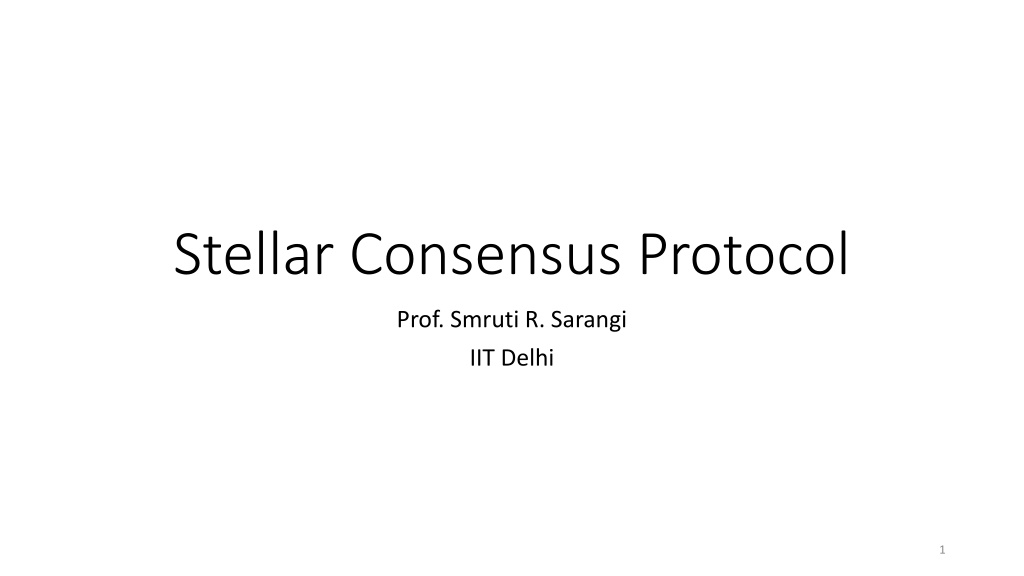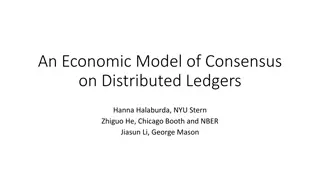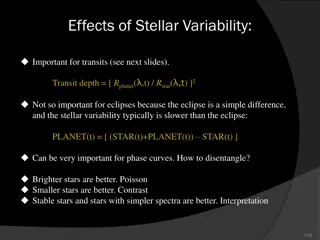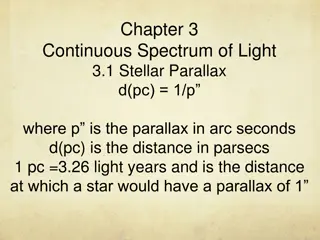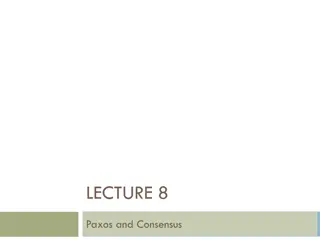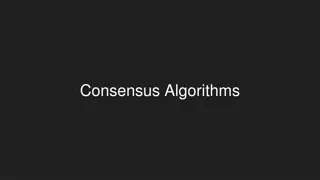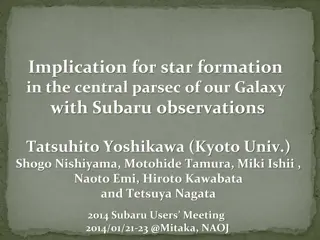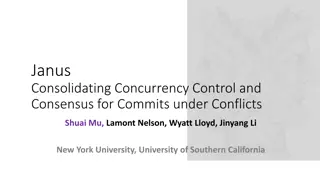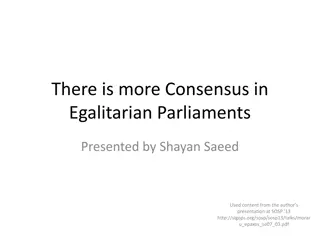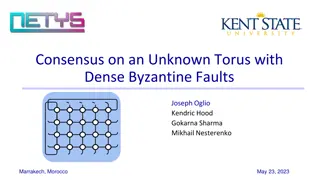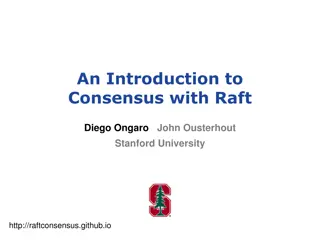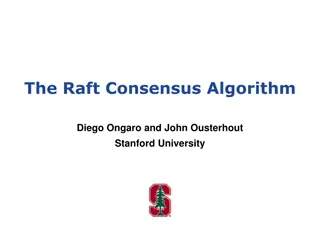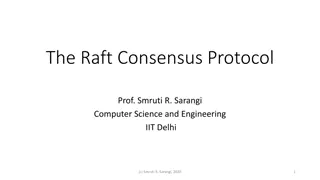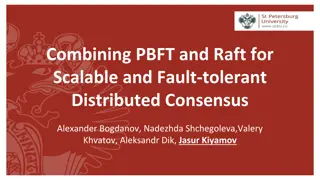Stellar Consensus Protocol
Explore the concepts of permissioned and permissionless blockchains, quorum slices, and the Federated Byzantine Quorum System in Stellar and Ripple. Delve into fault models, assumptions, and practical examples of quorums and quorum slices in distributed consensus protocols.
Download Presentation

Please find below an Image/Link to download the presentation.
The content on the website is provided AS IS for your information and personal use only. It may not be sold, licensed, or shared on other websites without obtaining consent from the author.If you encounter any issues during the download, it is possible that the publisher has removed the file from their server.
You are allowed to download the files provided on this website for personal or commercial use, subject to the condition that they are used lawfully. All files are the property of their respective owners.
The content on the website is provided AS IS for your information and personal use only. It may not be sold, licensed, or shared on other websites without obtaining consent from the author.
E N D
Presentation Transcript
Stellar Consensus Protocol Prof. Smruti R. Sarangi IIT Delhi 1
Types of Blockchains There are two kinds of blockchains Permissioned Permissionless Permissioned systems like Hyperledger All the participants are known. They can all be authenticated. Not suitable for open membership (any body can join) Permissionless systems Bitcoin and Ethereum Can implement cryptocurrencies 2
Notion of Quorums Fault model Byzantine faults Nodes can behave arbitrarily and maliciously Malicious nodes can also collaborate with each other Classic fault tolerance result with Byzantine faults With 3f+1 nodes, we can tolerate at the most f Byzantine failures. In this case, at least 2f+1 nodes make a quorum (all need to be correct) 3
New Ideas: Stellar and Ripple Federated Byzantine Quorum System (FBQS) The participants are not known There is no need for all the nodes to participate in a consensus protocol Every node chooses whom to trust (think of it as a private quorum) Such protocols are very modular and scalable 4
Background and Assumptions The universe of nodes: V A correct node executes as per specifications If a node is either correct or just fails (without sending any malicious messages), then it is dubbed as honest The rest of the nodes are faulty Partially Synchronous Network: After a global stabilization time (GST), all messages have a bounded delay The clock skew is bounded. 5
The key idea: Quorum slice Every node has a set of quorum slices (associated with it) A quorum slice is a set of nodes that the node trusts A node is a member of all of its quorum slices. A quorum is a set of nodes. Every node that is a part of a quorum also has at least one quorum slice in it (in the quorum). Assume that for the time being all the faulty nodes do not lie about their quorum slices. 6
Example of Quorums and Quorum Slices Node Quorum Slices v1 v2 {v1, v2} {v1,v2}, {v2,v3} v3 v3 v4 v4 We can have many quorums {v1, v2}, {v3}, {v4}, {v1,v2,v3,v4}, .... 7
Some Basic Requirements Every two quorums must intersect at a correct node. This correct node will ensure that there is common agreement (consensus) across all quora. Few more definitions: Two nodes, v1 and v2, are said to be intertwined, if they are both correct and every quorum containing v1 intersects every quorum containing v2 in at least one correct node. 8
Intact Set Projection of the FBQS S to set I ? ? ? ? ? = ? ? ? ?(?)} Projects all the slices to a given set S A set I is an intact set if 1. I is a quorum in S 2. All pairs in I are intertwined in S|I. 9
Let us understand a little bit more. Intact sets can reach a consensus I ?1 ?2 ? ? All intersecting intact sets are closed under union. ?1 ?2 ? (?1 ?2) is an intact set 10
Non-Blocking Byzantine Consensus for Intact Sets Given a maximal intact set I 1. Integrity No correct node decides twice 2. Agreement No two nodes decide differently 3. Weak validity If all nodes are honest, then the value that is decided is one of the proposed values 4. Non-blocking If all malicious nodes stop, then all the nodes ultimately come to a consensus. By the FLP result, we cannot guarantee termination if malicious/faulty nodes are active. 11
Key part of the algorithm: Federated Voting Properties Deliver (a ) Vote (a) For correct nodes 1. No duplication Every correct node delivers at most one voted value 2. Totality If a node in I delivers a voted value, every node in I delivers a voted value 3. Consistency If two intertwined nodes deliver a and a resp., a = a 4. Validity If all nodes vote for a, they eventually deliver a Reliable Byzantine voting 12
One Round of the Federated Voting Protocol Federated-voting (v ?,? ???) voted, ready, delivered false A tag indicates a round vote(a) if not voted then voted true send VOTE (t, a) to every ? ? v receives VOTE (t,a) from every node of a quorum U that it is a part of if not ready then ready true send READY (t,a) to every ? ? 13
FV Protocol (Part II) A set is v-blocking if it overlaps with every quorum slice of v A v-blocking set sends a READY (t, a) message if not ready ready true send READY (t,a) to every ? ? Can send a READY message for value that it has not voted for Received READY (t, a) from a quorumU that v is a part of if not delivered delivered true deliver (a) Similar to 2-phase commit 14
Insights The first READY message is received, only after the same VOTE message is received from the entire quorum Then it is propagated (a v-blocking set is enough) Termination is not guaranteed: Otherwise, it will violate the FLP result However, once one message is delivered The rest get delivered in finite time (for correct nodes), if we assume bounded clock skew 15
Some More Terminology Ballot <n, x> Value Positive number Total ordering: b < b (b.n < b .n) or ((b.n = b .n) and (b.x < b .x)) Compatibility if (b.x = ? .?) we write ? ? if (b.x ? .?) we write ? ? if ? ? and ? ? we write ? ? 16
Abstract Consensus Algorithm for node v ballots array of FV processes (specific to each ballot) candidate, prepared 0,? round 0 propose(x) Ensure all incompatible ballots with a lower number are voted out candidate <1,x> for all ? ?????????doballots[b ].vote(false) when for every ? ?ballots[b ].delivered(false) and prepared < b prepared b if candidate prepared candidate prepared ballots[candidate].vote(true) Ensure that the candidate ballot is accepted by all 17
Consensus Algorithm II when ballots[b].delivered (true) decide (true) Once, one true message is delivered, we know that the rest will also be delivered (property of intact sets). Declare victory A quorum is pretty much deciding for another round. There exists a quorum U (v is a part of it) s.t. for all u ? There is a ballot bu (associated with u) s.t. 1. round < bu.? 2. Either, {VOTE,READY} (bu, true) has been received from u OR received {VOTE, READY} (b , false) from u for every b ??, ??,??< ?? round min b?.? ? ?} start_timer Upgrade the round to be in sync with the quorum 18
Consensus Algorithm III Quite similar to propose(x) At a timeout: if prepared is uninitialized, candidate <round + 1, candidate.x) else candidate <round+1, prepared.x> for all ? ?????????doballots[b ].vote(false) 19
Some Basic Properties If some node decided on a ballot, some node must have prepared it If a node has prepared a ballot, some node must have proposed the value All nodes in the intact set decide the same value (if the protocol terminates) If quorum intersection holds, this is obvious. We need infinite state because the state of all the ballots and tags (rounds) has to be maintained. 20
Finite Version of the Protocol The main idea is that we cannot maintain an unbounded amount of state: all tags (rounds) and all ballots We need to do some garbage collection (dynamic removal basically) We need to maintain a subset of all messages (and throw out of messages that are beyond the range) instead of vote and deliver New Terminology prepare commit 21
New FV Algorithm prepare (b) If not voted for the current ballot (or later ones), then vote if (max-voted-prep < b) then max-voted-prep b send VOTE (PREP max-voted-prep) to all the nodes if there exists a maximum ballot b (> max-voted-prep) and if every node, u, in the quorum (containing v) sends VOTE (PREP bu) where ? ? ? ?? max-readied-prep b send READY (PREP max-readied-prep) to every node If it receives a bu where lower and incompatible ballots are alive, it waits Always consider the maximum ballot 22
Finite Version of the FV Algorithm II if there exists a maximum ballot b (> max-readied-prep) and if every node, u, in a v-blocking set sends READY (PREP bu) where ? ? ? ?? max-readied-prep b send READY (PREP max-readied-prep) to every node Just propagate READY messages if there exists a maximum ballot b (> max-delivered-prep) and if every node, u, in the quorum (containing v) sends READY (PREP bu) where ? ? ? ?? max-delivered-prep b prepared (max-delivered-prep) Finally deliver the prepare message 23
The Commit Function commit (b): if ? ???????_?????_???and max-voted-prep = b then ballots_voted_cmt ballots_voted_cmt b send VOTE (CMT b) to every node A prepared ballot is committed (done only once) when received VOTE (CMT b) from a quorum and b ???????_???????_??? ballots_readied_cmt ballots_readied_cmt b send READY (CMT b) to every node Send READY messages after a quorum votes 24
Commit Function II when received READY (CMT b) from a v-blocking set and b ???????_???????_??? ballots_readied_cmt ballots_readied_cmt b send READY (CMT b) to every node Propagate READY messages when received READY (CMT b) from a quorum and b ???????_?????????_??? ballots_delivered_cmt ballots_delivered_cmt b committed (b) Finally commit the message (like prepare) 25
Consensus Protocol candidate, prepared, and round are initialized P voting process propose (x) candidate <1, x> P.prepare (candidate) Prepare phase when triggered P.prepared (b) and prepared < b prepared b if candidate prepared candidate prepared P.commit (candidate) Commit phase When committed, decide (b.x) 26
Both the algorithms are equivalent Timeout Same as the algorithm with infinite resources If a node receive messages for later rounds (from the entire quorum) Set the round to the minimum value of bu.n in the quorum. Start a timer After a timeout Increment the round and prepare again 27
Lying about Quorum Slices We do not make any assumptions about faulty nodes As long as we have an intact set that guarantees a non-empty quorum intersection comprising correct nodes, there is no problem All these protocols are obstruction free This means that if the faulty nodes stop Consensus is achieved (subject to bounded clock skew) 28
Key Lemmas in the Proof Sketch 1. If two nodes in an intact set send READY (t, a) and READY (t, a ) messages, then (a=a ). 2. If a node v1 commits a ballot b1, then the largest ballot b2 prepared by any other node in the same intact set (before the commit) is such that b1 b2 3. All correct nodes in an intact set ultimately decide the same value (if the algorithm terminates) 4. It is a proposed value. 29
Conclusion The notion of quorums and quorum slices is the most important. They need to be constructed wisely. Practical implementations are very fast. Some guarantees regarding the reliability of intersecting nodes and partial synchrony need to be made. 30
References [Main reference] Garc a-P rez, lvaro, and Maria A. Schett. "Deconstructing stellar consensus (extended version)." arXiv preprint arXiv:1911.05145 (2019). [Original paper] Mazieres, David. "The stellar consensus protocol: A federated model for internet-level consensus." Stellar Development Foundation 32 (2015): 1-45. 31
Thank you (c) Smruti R. Sarangi, 2020 32
